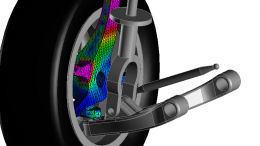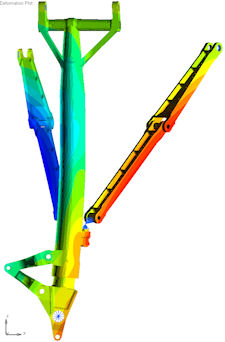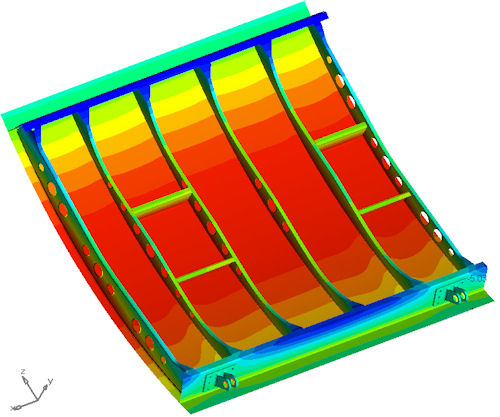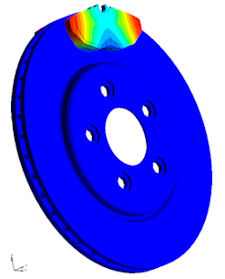Fatigue Analysis Integrated into MSC Nastran 2013
Nastran also offers greater acoustics, nonlinear and explicit capabilities, and improved performance for HPC environments.
June 26, 2013
 MSC Nastran image courtesy of MSC Software Corp. |
MSC Software Corp. (Santa Ana, CA) has announced the release of MSC Nastran 2013. Key enhancements reported by the company include integrated fatigue analysis for optimizing designs for weight and durability, extensions to the solver’s acoustics, nonlinear and explicit behavior capabilities, and enhancements for HPC (high-performance computing) applications. MSC Nastran 2013, says the company, delivers customization and broader solution capabilities that generate significant time savings in automotive and aerospace simulation workflows.
MSC Software describes its new MSC Nastran Embedded Fatigue (NEF) fatigue analysis as coupling the stress and fatigue calculation processes into a single simultaneous operation. Thus eliminating the need to export results to a separate fatigue solution. NEF, it says, allows engineers to include materials and loading information with the model data in the Nastran input file and then calculate fatigue damage and life using the MSC Nastran solver.
 MSC Nastran image courtesy of MSC Software Corp. |
The company explains that embedding what was once a post-processing exercise into the analysis process allows users to perform weight optimization while constraining fatigue life. It adds that time savings are achieved by avoiding sequential process steps in the durability calculations. This, it says, reduces both computational time and improves ease of use. By way of an example, the company cites a fatigue analysis that traditionally took eight hours to run now takes just 38 minutes and reduces files to process from 200 down to two.
Users can now also perform design optimization in conjunction with fatigue analysis, which can lead to better, longer-lasting designs. The company offers an example that led to a 24% mass reduction and a fatigue life increase of 14%.
Among the fatigue capabilities in MSC Nastran 2013 are stress-life solver (full capabilities similar to MSC Fatigue), FOS (factor of safety) analysis (both S-N & E-N), and the ability to process multi-axial responses using the Critical Plane method. The embedded fatigue capability also supports parallel processing (up to 100 threads) and multiple fatigue analyses can be performed in a single job submittal.
MSC Nastran 2013 now also supports the poroelastic behavior of trim components, such as those used in automobiles and aircraft to dampen vibrations and improve cabin comfort. The new support for poroelastic behavior of trim components enables engineers to analyze the vibroacoustic performance of a vehicle by modeling the complex multiphysics of the fluid-solid interactions, which is said to result in improved simulation accuracy.
 MSC Nastran image courtesy of MSC Software Corp. |
For applications involving advanced nonlinear system analyses, MSC Nastran 2013 offers improvements to its user-defined material subroutine, including the ability to define new state variables and the ability to pass additional internal variables. The software’s enforced relative motion capability is said to have been improved for better nonlinear dynamic analysis of structures. Additionally, MNF (modal neutral file) files used by the company’s Adams multibody dynamics software to simulate deformation in flexible bodies can now be exported at a deformed configuration.
Version 2013 of MSC Nastran also incorporates several new capabilities said to improve the performance of numerically intensive blast applications. Among these are new 1D to 3D and 2D to 3D axisymmetric mapping for blast loads in the Eulerian solver. With this capability, says the company, users can improve the computational speed of analyses by performing 1D or 2D analyses and mapping the results to a 3D mesh to account for the effect of the wave on a structure.
 MSC Nastran image courtesy of MSC Software Corp. |
For analyzing multiple blasts and their effects on structural integrity, version 2013 supports multiple detonation points with varying ignition times. Other enhancements for blast application include a new methodology to define blast loads based on empirical data in LS-Dyna and new LS-Dyna libraries based on LS-Dyna version MPP 971s R6.0.
MSC Nastran 2013 also incorporates enhancements for general FSI (fluid-structure interaction) applications. Enhancements to the software’s FSI algorithms are said to speed up simulation times. The company says that single core runs see over 60% improvement with multicore runs returning even better performance.
MSC Nastran, says the company, delivers performance improvements for a variety of analyses in HPC (high-performance computing) environments. Greater use of parallelization and GPGPU (general-purpose graphics processing unit) technology are said to result in a 20% to 50% reduction in solution times over previous releases. Additional HPC-related enhancements include more efficient DMP (distributed memory parallel) capabilities for advanced nonlinear analyses as well as new memory management that minimizes memory usage and conserves resources in multi-user environments.
MSC Nastran 2013, according to the company, will be available for 32/64-bit Windows platforms as well as 64-bit Linux systems “in the next few days.” For more information on MSC Nastran 2013, click here. Go here to learn more about MSC Nastran Embedded Fatigue.
Watch a presentation on MSC Nastran 2013 release highlights.
Watch some videos on MSC Nastran 2013 for automotive and aerospace.
Find some more application sample videos here.
Download the MSC Nastran brochure.
Download the MSC Nastran Embedded Fatigue datasheet.
See why DE’s Editors selected MSC Nastran 2013 as their Pick of the Week.
Sources: Press materials received from the company and additional information gleaned from the company’s website.
Subscribe to our FREE magazine, FREE email newsletters or both!
About the Author
Anthony J. Lockwood is Digital Engineering’s founding editor. He is now retired. Contact him via [email protected].
Follow DE





